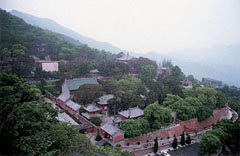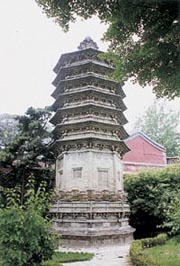 |
|
| The Jietai Temple |
| CCTV.COM 2003-07-23 09:07:22 |
|
 The Jietai Temple is located at the foot of Ma’an Mountain, west suburbs of Beijing. It was built facing east. Its construction follows the contour of the mountain, scattered but well spaced. Due to its important status in Chinese Buddhist world, the stand in it has been able to confer the highest rank in Buddhism, the Bodhisattva Discipline. Thus the temple, also the highest Buddhist academy in China, was named after this ceremonial stand. The Jietai Temple is located at the foot of Ma’an Mountain, west suburbs of Beijing. It was built facing east. Its construction follows the contour of the mountain, scattered but well spaced. Due to its important status in Chinese Buddhist world, the stand in it has been able to confer the highest rank in Buddhism, the Bodhisattva Discipline. Thus the temple, also the highest Buddhist academy in China, was named after this ceremonial stand.
“There’s an interesting story. The stand was originally called altar, just like other altars of the heaven, the earth, the moon and the sun. It was a construction for Buddhist rituals. Beautiful views were inside the temple. When the emperor came, he wandered around. At a sudden literary impulse, he wrote a poem, in which he used the word “stand” instead of “altar”. How could an emperor change words from his mouth? Thus the temple was named ‘Jietai’, meaning ‘stand to confer Buddhist disciplines’,” said Hu Xiaowei, scholar of humanity.
The temple layout is very unique. Almost all houses in Beijing are built facing south, particular so with a courtyard main entrance. But as the first Buddhist temple for its function in China, giving full status to a monk or a nun, the temple gate was built facing east.
“Most of the houses in Beijing face south, for getting as much sunshine as possible. But the temple gate is facing east. What’s the secret? During the Liao Dynasty, Khitan, nomadic people in north China, worshipped the sun god. They took the east as superior among others. That’s why temples built then had gates facing the east,” said Hu Xiaowei.
Although the temple’s construction layout took shape during the Liao, about 1000 years ago, its buildings preserve styles of Ming and Qing dynasties. In addition, it has several Beijing traditional courtyard houses.
Most temples take their gate hall as the main entrance. But the Jietai Temple is an exception, which makes its gate hall into a square courtyard, taking its south subordinate gate as the chief entrance to the courtyard, an rare case among other temples in Beijing.
“The square courtyard is a traditional form with several thousand years history in China. Most buildings, from imperial palaces, to temples or dwellings of ordinary people, are of this form, particularly in the north. But the courtyard of this temple is special, its key construction was the square altar. This made the courtyard more characteristic, with verandas on each side,” said Luo Zhewen, expert on ancient architecture.
 The altar hall is both the symbol and the chief building of the temple. The altar inside was the place for ceremonies to confer Bodhisattva disciplines, called the First Altar under Heaven”. The altar hall is both the symbol and the chief building of the temple. The altar inside was the place for ceremonies to confer Bodhisattva disciplines, called the First Altar under Heaven”.
Many constructions of Liao Dynasty are still seen. These two tomb pagodas and the tablet were among them, still well-preserved after repeated repairs through history. The bi xi, a legendary animal carrying the tablet on its back, is an original from Liao.
The temple boasts a lot of ancient trees, among them, probably the pine trees the most famous. Most of them are over a thousand years old, weathered through history, having adopted unusual forms for scholars to exclaim and chant about.
Unique construction layout, long history and unusual old pine trees make the temple a tourist must place today.
|
|
Editor: Liu Baoyin CCTV.com
|
|
|
|
|
|
 |









